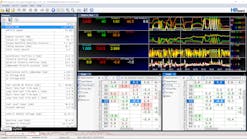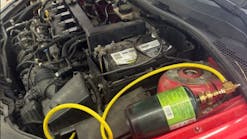Scan tools are a vital part of the diagnostic process, and these tools have come a long way in the past ten years or so.
From simple maintenance procedures such as identifying codes and performing resets, to advanced programming and ADAS calibrations, the use of scan tools is not only recommended but essential.
The features and functions available on today’s scan tools don’t stop at the vehicle diagnosis. Rather, scan tools and scan tool software now go a step further by logging data directly into a customer file, and helping technicians provide very thorough – and revenue-generating – service. They help to connect technician and customer, ‘verify’ a repair, keep track of maintenance, and earn repeat business.
When weighing various scan tools to purchase and overall ROI, it pays to look at vehicle coverage features and diagnostic functions … of course. Today’s tools now offer functions like built-in TPMS, the ability to do J2534, key programming options, remote diagnostics, and ADAS. Even so, technicians should also consider features that help to document and share repair information with other technicians in the shop and their customers.
Here’s a look at how documenting and reporting functionality can ‘close the loop’ in a successful repair experience.
Sharing detailed information
A number of diagnostic products offered today allow technicians to share diagnostic repair information with customers in an easy-to-understand way. For example, Launch Tech USA’s x431 professional diagnostic tool family (includes x431 Turbo, x431 Torque, and x431 Throttle) feature a Vehicle Health Report function that allows for digital sharing with customers, as well as gives the shop and technician the ability to print a hard copy report for customers. Both pre-scan reports and post-scan reports are prepared for each repair.
Documentation such as this goes a long way to bring customers peace of mind with their vehicle.
“The reports bring all issues and concerns to light in easy to follow, summarized detail,” says Launch Tech USA Director for North America Rogers Thiamthat regarding the company’s Vehicle Health Reports.
Repair documentation helps customers understand their vehicle problems in an often “too technical” automotive repair world, says Thiamthat. He adds, this additional information can remove the notion on the customer’s part of a ‘bait and switch’ tactic – meaning what they originally thought was an issue, versus what someone without a professional diagnostic tool says might be an issue.
No rock left unturned
Sharing brief, easy-to-navigate details regarding the repair process with customers may even uncover issues that were not initially identified.
Launch Tech’s Thiamthat believes this lets customers make the best decision possible to solve any and all vehicle problems and avoid comebacks.
“There may be cases where customers might not opt to repair right away, even [learning and understanding information presented in] the Vehicle Health Report,” says Thiamthat. “[The report], however, at least keeps customers aware of known issues and they can be proactive in getting everything in order.”
Reaching out … without sacrificing productivity
One factor that often prevents businesses from going the extra mile to share detailed information with customers, is the notion that it takes additional time and takes workers away from the primary task. However, that doesn’t have to be the case in automotive repair and service.
The company Snap-on Diagnostics offers pre- and post-scan reports with their products. The information can be uploaded and shared close to real-time, without as much as a phone call.
The technician can share vehicle system reports and images via text or email, share pre-scan reports and images with customers to receive quick approvals for repair, and forward pre- and post-scan reports and images to insurance companies to confirm OEM repair requirements have been met. So not only does this practice not add more time, it can save time on the back-end when integrated into a diagnostic process.
“When connected to Wi-Fi, you can automatically upload images, vehicle system reports, and pre- and post-scan reporting to the Snap-on Cloud,” says Dave Hall, Snap-on Diagnostics Director of North American Sales. “Once [the information is] in the cloud, it can be accessed by a phone, tablet, or computer whenever the technician or customer needs them. The Snap-on Cloud works to make each job faster. Once connected by Wi-fi, every image or pre- or post-scan vehicle system report is captured automatically.”
Hall says new features afforded diagnostic products on the market are all about improving information and workflow for the shop.
“Technicians can mark and order files, identify images as ‘known good’ or ‘known bad,’ tag files to make a keyword search fast for future reference, and retrieve files by customer name, VIN, or sort by date, allowing for easy retrieval.”
In addition, they can compare and share information with peers and share images with other shops and technicians for the best possible intelligence.
These services are a boon to customers, who cans can get immediate information from the shop and give approvals for work. The shop can also provide their customers with copies of both the pre- and post-scan report and any related images to be able to give them confidence in the shop and repairs carried out. They also can get a good understanding of the full health of their vehicle, any pending codes, or preventative maintenance work that may need to be carried out in order to keep their vehicle in full working order.
Thiamthat says features like Launch Tech’s Vehicle Health Report bring important service issues to customers’ attention. He says such reporting can also make shops aware of issues or repairs they may not be equipped for.
Reporting features are a relationship builder, sealing the trust between shop and customer. “With this relationship comes lasting effects, such as repeat business, great reviews (which also drives more business), and referrals that provide feedback of a detailed, thorough, inciteful repair,” says Thiamthat.
“We absolutely do not want to put a customer in a situation of being caught off guard on a preventable problem, or a high priority problem that needed immediate attention.”
So much of vehicle work nowadays is ‘invisible,’ with issues vehicle owners may not see or feel. But today’s top diagnostic tools offer features and capabilities to keep repair issues – and customers – out of the dark.



